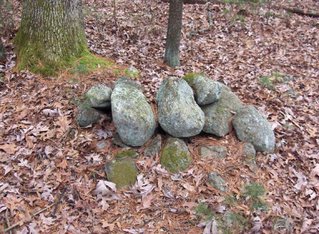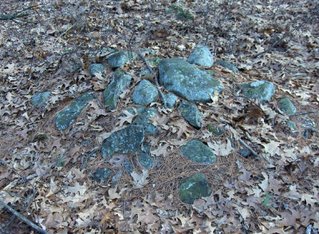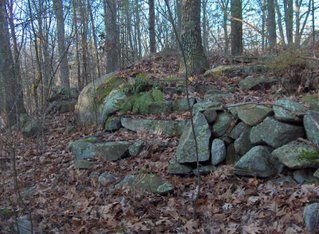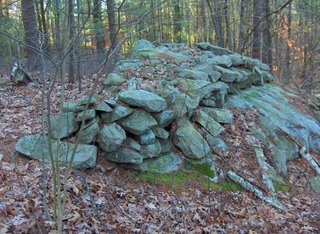I still believe some of what I wrote here:
Several years ago I found a rock pile on a boulder that suggested the shape of a female sitting cross-legged. Later a friend found a second example, of almost identical design, and I started taking seriously the idea that the Indians might have deliberately constructed rock pile effigies - that these might not be just a figment of my imagination. Here, I want to set the stage for a
gallery of photos I have been collecting, so the reader can judge for themselves. In the course of the last year, finding between fifty and one hundred of these "pictorial" rock piles, I have come to believe they are examples of representational art that were part of a ceremonial tradition of the New England Indians. In particular these rock piles are always found near a source of water, such as a seasonal spring or a vernal pool, they tend to be oriented in particular compass directions that are consistent with what is pictured (for example female figures usually face the Southeast), they usually occur in groups, and they usually are found near other anomalous rock constructions such as split-rocks filled with cobbles, rocking stones, and perched rocks.
In the Concord area there are many different kinds of rock piles. Traditionally these are viewed as field clearing piles, or as manuring piles for enriching the soil. To consider rock piles as all the same, all belonging to one (or at most two) categories is an oversimplification. A brief survey (Waksman, Neara Journal Summer 1999) finds that some piles are tossed together, others well constructed. Some are made from glacial till, others from broken ledgerock. Some lie at the angle of repose, others are domed, and others are flat. Some occur in isolation on high ground, others occur in groups at the edges of swamps. Given this variety, "rock piles" should not be considered as a single type of construction, and generalizations should be avoided.

The rock piles I am talking about consist of a single layer of cobbles lying in a horizontal plane on top of a larger support boulder. The piles usually have an axis of symmetry with one prominent round cobble at the top of the axis. The individual cobbles have diameters in the range of six to twelve inches. Since these piles are delicate, they are often damaged with their cobble positions jumbled. So finding one in perfect condition is rare.
Certain facts support the idea that these effigies are a reality, and the reader is urged to go out and see for themselves. These facts are: correlation with water, standard designs, correlation with direction and view of the landscape, clustering and localization of the piles, and the use of particular colored cobbles. These features are non-random and support the idea that these rock piles are special, curious, and definately not related to pragmatic use. Some of them are even beautiful in their simplicity, which qualifies them to as art.
Correlation with Water
There is a strong correlation between springs (places where water comes out of the ground - possibly seasonally) and such rock piles. When a rock pile is found in a location far from water, it does not conform to this description - usually consisting of several layers, with no axis of symmetry and no shape. Conversely, when a spring is examined, in an out-of-the-way part of Concord/Carlisle/Acton/Stowe/Lincoln, in most cases you will find a cluster of exactly these types of rock piles, overlooking the source of the water.
Clearly there are many springs in the midst of modern construction, and failing to find effigies at a spring should not be surprising. But in the middle of deep woods where there is a spring, this author is surprised if no low rock piles occur. When this happens, I find either that there is no good view of the horizon or else there are telltale traces of some past logging or gravel operation nearby. What this suggests is that every spring had its rock piles, every source of water was an oportunity for ceremonial contruction - something hard to accept.
Standard DesignsCertain designs occur repeatedly and have specific characteristics. For example:
Woman:

Man:

Turtle:

The most characteristic features of the "Female" is the W-shaped rock for the breasts and the flat pedestal at the bottom. A variation is for the breasts to be formed from two similar sized cobbles. The most characteristic feature of the "Male" is the horizontal crossbar, which is sometimes formed with a row of similar sized cobbles. The most characteristic features of the "Turtle" are a larger domed boulder, with a small shelf close to the ground and a single slightly pointed (beaked) rock resting on the shelf. Some slightly less expected rock pile designs are seen repeatedly:
Bird:

Twins:

Crystal:

The most characteristic features of the "Bird" are the slightly pointed head, the elongated symmetric placed wings and the trapezoid shaped tail. The characteristic of a "Twins" pile is the two curious "boat rudder"-shaped rocks next to each other. The characteristic feature of a "Crystal" rock pile is a central rock with unusual color or crystals, ensconsed symmetrically by other rocks.
There are also miscellaneous other designs which suggest a particular species or have a noticeable symmetry. But these above are reasonably common, as shown in the photos below.
Correlation with Direction and View
The axis of symmetry, in the direction from the prominent "head" cobble usually points in a particular direction that is specific to the particular design. Also most piles are located with a view out over the water (or swamp) and there is some corelation between this direction of view and the design. This is not a perfect correlation but is reasonably strong. In particular "females" typically face to the Southeast; "males" typically face to the West; "turtles" and "birds" typically have their head to the Northwest.
Clustering and Localization
These rock piles usually occur in groups of between five to twenty piles. With a couple of exceptions they do not occur in isolation. The groups, as already noted, are always localized to places where there is a view of a nearby water source. It seems clear that such clustering and localization is not random and my friends and I are preparing a density distribution map which will show this clearly.
Use of Colored Cobbles
Most cobbles around here become grey with lichen after exposure to the air for several years. Some rocks do not support good lichen growth and retain a natural coloring. These include black rocks, white rocks (such as quartz and feldspar), brown quartzite, and iron-rich red rocks. Possibly these colors are being used deliberately. It is common to find a black rock juxtaposed and paired with a white rock, across the axis of symmetry. Something like this:

 The tallest hill in Chelmsford is Robbins Hill and it's southwestern slope is covered with old broken down rock piles. Most seem to be made with burnt rock, suggesting to me there were lots of fire up here sometime in the past. Why make this site public? Well it is old and already badly broken down. Some kind of paintball/scout activity has re-used the piles for little jumps and little fireplaces so I cannot see much hard in mentioning it. I do not think these are burials, for several reasons, and the worst that could happen is somebody could go up there and kick some of the rocks around.
The tallest hill in Chelmsford is Robbins Hill and it's southwestern slope is covered with old broken down rock piles. Most seem to be made with burnt rock, suggesting to me there were lots of fire up here sometime in the past. Why make this site public? Well it is old and already badly broken down. Some kind of paintball/scout activity has re-used the piles for little jumps and little fireplaces so I cannot see much hard in mentioning it. I do not think these are burials, for several reasons, and the worst that could happen is somebody could go up there and kick some of the rocks around.
 Note the quartz in front of this last one.
Note the quartz in front of this last one. Consider these features:
Consider these features:














































